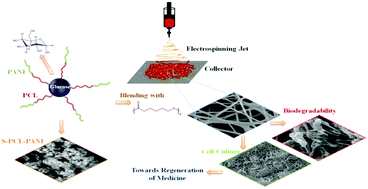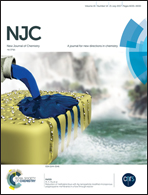Conductive and biodegradable scaffolds based on a five-arm and functionalized star-like polyaniline–polycaprolactone copolymer with a d-glucose core
Abstract
This study was aimed at the fabrication of three-dimensional, conducting, biocompatible, and porous scaffolds for the mouse osteoblast MC3T3-E1 cells for tissue engineering applications; these scaffolds were composed of novel star-like polycaprolactone–polyaniline (S-PCL–PANI) with D-glucose as a core. The electroactivity and mechanical properties of a scaffold play important roles in adhesion, differentiation, and proliferation of different cells. Herein, S-PCL was synthesized via ring-opening polymerization that was initiated by D-glucose with the tin(II) 2-ethylhexanoate (Sn(Oct)2) catalyst. Then, S-PCL reacted with p-anthranilic acid to afford the S-PCL macromonomer S-PCLM. S-PCL–PANI was synthesized through the copolymerization of the macromonomer with aniline monomers via chemical oxidation polymerization. For strengthening the overall mechanical performance, the solutions of the chemically synthesized S-PCL–PANI and high molecular weight PCL were electrospun to produce uniform conductive nanofibers. The morphology, electrical conductivity, in vitro degradability, biocompatibility, hydrophilicity, and mechanical characteristics of the nanofibers were thoroughly investigated. The resulting scaffolds possessed a porous structure (the diameter of the nanofibers ranged from 30 to 50 nm) with large surface area, high electrical conductivity (0.03 S cm−1), and star-like morphology; moreover, these imitated the natural microenvironment of the extracellular matrix (ECM) to regulate cell attachment, proliferation, and differentiation. In vitro cytocompatibility studies performed over 168 h indicated that the S-PCL–PANI/PCL nanofibers were non-toxic to mouse osteoblast MC3T3-E1 cells.



 Please wait while we load your content...
Please wait while we load your content...